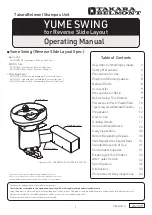
Long Range Mount Installation
¤
2005-2010 SR Research Ltd.
45
Power Cabling:
There are several possible sources of DC power for the Long Range EyeLink
1000. All sources of power plug into the Camera Head and Illuminator using pressure-release
LEMO connectors. The connectors can be unfastened by squeezing firmly at the very ends of
the connectors at the position where raised arrows appear in the rubber covering on either side
of the connector. Squeeze tightly at these pressure points and firmly pull the connectors apart.
The power sources are:
1.
DB-9 Patch Panel Solution:
An AC power converter that connects via a 9 pin D-
shaped, DB-9 (D-SUB) connector to a separate cable with pressure-release connectors.
2.
BNC Patch Panel Solution:
An AC power converter that connects via BNC connectors
to a separate cable with pressure-release connectors.
3.
Rechargeable Battery System:
A Battery Pack power system that is situated near the
eye tracker and has a cable with pressure-release connectors.
Figure 7-7: Male DB-9 connector (left-to-right), gender
changer with female connector showing, BNC connectors,
LEMO connectors, and Battery System
The first two power solutions listed above are designed to pass line-filtered DC power through a
patch panel or filter plate into an RF-shielded room, such as an MRI room. The AC converter is
designed to plug into an RF line filter before connecting to the patch panel / filter plate. The
second cable is intended to connect the Camera Head and Illuminator to the patch panel /filter
plate source inside the room.
D-SUB Patch Panel Solution.
In the case of the first solution listed above, DB-9 connectors
(see two left images in Figure 7-7) are used on either side of the patch panel / filter plate with
the assumption that the filter plate connectors are male on one side of the plate and female on
the other. A DB-9 gender changer is supplied (as is an RF noise-attenuating filter) for use on
the power source connected to the filter plate.
BNC Patch Panel Solution.
In the case of the second solution listed above, the power comes
from the AC converter and plugs into a cable with red and white color-coded BNC lines (see
third image from the left in Figure 7-7). The BNC connectors attach to the patch panel / filter
plate BNC terminals and a similar connector attaches to the BNC terminals on the other side of
the filter plate inside the shielded room, before connecting to the cable leading to the Camera
Head and Illuminator. It is CRITICAL that the colors of the BNC connectors match on either
side of the patch panel / filter plate. That is, if the red-color coded connector plugs to a BNC















































